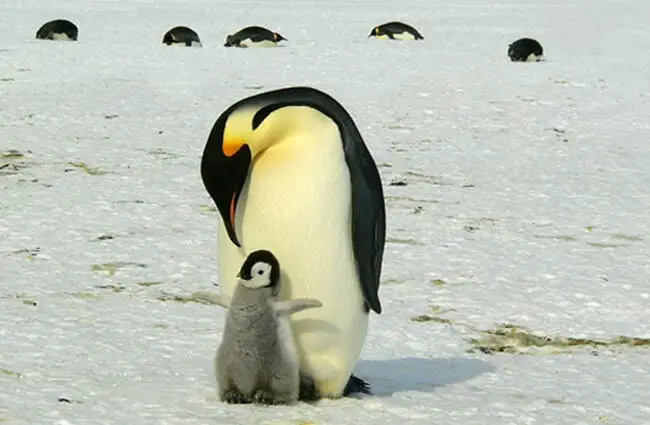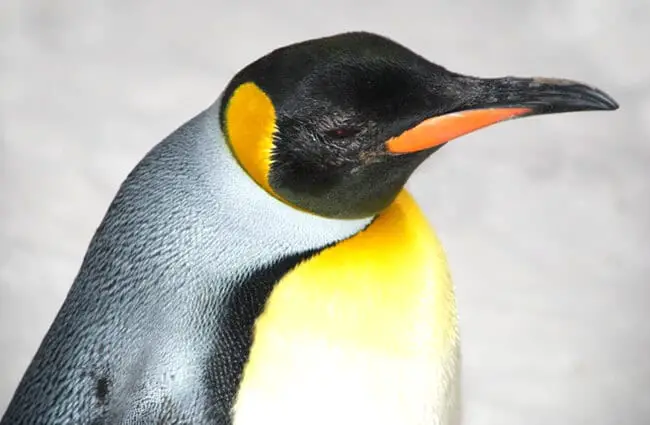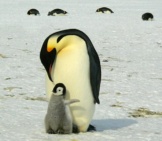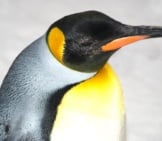These massive birds are the classic image of a penguin. Emperor penguins are the largest of the penguin species, standing as tall, and weighing as much as a small child! Read on to learn about the emperor penguin.
Description of the Emperor Penguin
These heavyweight penguins can weigh up to 99 lbs., and stand up to 2 ft. tall. They have the classic “tuxedo” look, with black/gray backs and flippers, and white bellies. Their heads are also black, and their necks are white with a yellow/orange hue. They have two black feet, and a short, thick tail.
Interesting Facts About the Emperor Penguin
Penguins as a whole are incredibly interesting creatures. They have evolved so differently from many other bird species, and have a number of fascinating behaviors and traits for survival.
- Feathers, Not Fur – Penguins’ short, dense feathers look almost exactly like fur, but penguins are birds! Just like any other bird, penguins have feathers instead of hair. These feathers are short and close together to insulate the penguins against the cold, and repel water.
- Cold Weather Penguins – Emperor penguins live in Antarctica, and can withstand harsh, freezing temperatures. When most people picture penguins, they see black and white birds frolicking in the snow, but 10 of the 18 species of penguin actually live in warm climates. There are penguins on the coasts of The Galapagos Islands, South Africa, New Zealand, South America, and Australia.
- When We Say Harsh Temperatures, We Mean Harsh Temperatures! – Freezing cold has no meaning unless you have traveled to Antarctica. Wind chills on Antarctica can reach a frigid -76º F. To withstand this cold, penguins huddle together in large groups to conserve body heat.
- Winter Travels – It is during the freezing days of winter that penguins choose to breed. The female penguin lays one egg, and passes it over to dad’s feet so he can incubate it. Then she ditches him for two months to go fishing! This hunting expedition is so time-consuming because she may have to walk up to 50 miles to reach the sea. Once she has a full belly, she returns to the group to feed her partner and her chick.
Habitat of the Emperor Penguin
Emperor penguins live exclusively in frigid Antarctic environments. They prefer to breed during the winter, when pack ice freezes and stabilizes. These penguins will usually create breeding colonies in areas close to icebergs and frozen cliffs, which protect them from the worst of the harsh winds.
Distribution of the Emperor Penguin
Emperor penguins live exclusively in Antarctica, and are almost always found between the 66º and 77º south latitudes. They can be found around the entire continent within the pack ice that freezes around the continent.
Diet of the Emperor Penguin
These penguins feed mainly on fish, crustaceans, and squid. When hunting, emperor penguins can dive to incredible depths. They have been known to dive up to 3,000 ft. deep! The most frequent feeding strategy involves diving to around 150 ft. deep, and looking up for fish swimming against the bottom of the sea ice. Most emperor penguins feed primarily upon Antarctic silverfish, though they also prey on cod, krill, and squid.
Emperor Penguin and Human Interaction
Because emperor penguins live in such a harsh environment, they have had very little human interaction in the past. Penguin hunting did occur, but usually in colonies of other species living closer to sub‑antarctic waters.
Unfortunately, that doesn’t mean that emperor penguins get off easy. While emperor penguin numbers are steady, the imminent threat of global climate change places these birds in jeopardy. Every year, as global temperatures increase, the pack ice these birds breed on gets thinner and smaller.
Domestication
Emperor penguins have not been domesticated in any fashion.
Does the Emperor Penguin Make a Good Pet
Emperor penguins are incredibly difficult to care for because they require an extremely controlled environment, particularly temperature. The cost of building a habitat, upkeep, and keeping the animals properly cared for is immensely expensive.
Emperor Penguin Care
When they are kept in zoos, emperor penguins require very stringent care. Their habitat must be temperature controlled to replicate their natural habitat, and they must be provided a similar diet of fish, squid, and crustaceans. This food must all be restaurant quality to prevent illness in the birds. Because emperor penguins are highly social, they must also be provided with plenty of other penguins to socialize with!
Behavior of the Emperor Penguin
Emperor penguins are highly social birds, and can be found in extremely large colonies. In addition to breeding colonies, these penguins also travel and forage in groups. Though they may dive and surface around the same time, scientists are unsure if they cooperate while fishing.
Emperor penguins hunt exclusively in the water, and are excellent swimmers. They swim by “flying” through the water, flapping their wings in an up and down motion. This is the only flying they do, as penguins are flightless birds.
Reproduction of the Emperor Penguin
Emperor penguins breed in the Antarctic winter months of March and April. The penguins find mates using courtship calls and displays. Once they have chosen a mate, they will remain with the same mate 85% of the time.
Female penguins lay a single egg, and transfer it onto the male’s feet. While the female returns to the sea to fish, the male incubates and hatches the chick. After 64 days, the chick hatches from the egg. If the mother hasn’t returned, the father feeds the chick from a special gland in his throat, despite the fact he hasn’t eaten for months!
Once the mother returns, she takes over care of the chick, while the male returns to the sea to feed. By December and January, the chicks will have grown their adult feathers, and travel to the sea to begin hunting for themselves.











![Red Angus Closeup of a beautiful Red Angus cowPhoto by: U.S. Department of Agriculture [pubic domain]https://creativecommons.org/licenses/by/2.0/](https://animals.net/wp-content/uploads/2020/03/Red-Angus-4-238x178.jpg)












![Red Angus Closeup of a beautiful Red Angus cowPhoto by: U.S. Department of Agriculture [pubic domain]https://creativecommons.org/licenses/by/2.0/](https://animals.net/wp-content/uploads/2020/03/Red-Angus-4-100x75.jpg)

